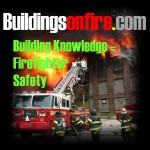The Strand Theatre Fire Brockton (MA) 1941; 13 Firefighter LODD
By Christopher J. Naum, SFPE on Mar 10, 2011 with Comments 0
Strand Theatre Background
The Strand Theatre was first erected in 1915 on the site of a previous theatre which was destroyed by fire on April 7, 1915. The Strand Theatre opened in March, 1916 on School Street between Main Street and City Hall in Brockton. It replaced another theatre that was destroyed by fire April 7, 1915. With a seating capacity of 1,685, it was the largest playhouse in the City.
When opened, the Strand Theatre was considered a leader in modern fire safety. The stage area included a dry pipe sprinkler system termed “fireproof” and the surface exits were 20% more than state law requirements.
Located on an irregular lot, the Theatre measured 139 feet deep and 60 feet tall. The walls were made of brick and the roof was made up of wood boards on joists supported by unprotected steel trusses. The interior walls were metal lath and plaster as was the ceiling, which was suspended from the trusses. The balcony covered a large area above the auditorium and housed a manager’s office, usher’s room and rest rooms. The area under the auditorium was dead space with the exception of the west end of the basement where finished rooms contained the furnace, ventilation equipment and a janitor’s room. The lobby was an open area with two open stairwells on each end providing access to the balcony. A long corridor connected the Theatre lobby to School Street.
In August, 1937, the Strand Theatre underwent extensive remodeling and improvements under new management. The building remained intact under the new management until the fire occurred in 1941.
March 10, 1941: The Stand Theatre Fire
In the heart of Brockton’s business district, people usually flocked to the downtown area to shop or take in a show in what was a busy part of the city. Sunday, March 9, 1941, like all other Sundays, drew large crowds looking for the entertainment of a movie or vaudeville show. That evening the Strand showed the double feature, “Hoosier School Boy” starring Mickey Rooney, followed by “Secret Evidence,” a crime drama.
Long after the curtain had closed and the crowds had filtered out, a custodian discovered a fire burning in the Theatre basement and instructed his helper to activate the fire alarm box located at Main and High Street. At 12:38 a.m., the fire department received Box 1311 and sent the first alarm apparatus to the scene. A second alarm followed shortly after the first, and finally a general alarm was sounded bringing all of Brockton’s apparatus to the Strand Theatre.
When firefighters first arrived on the scene, the fire did not seem very serious. However, as time progressed, the fire gained headway. This became more apparent to those on the outside of the theatre than crews working inside.
Crews knocked down the fire in the basement with cellar pipes while flames raced through the vertical voids in the walls and ventilation ducts. Firefighters worked feverishly to extinguish hidden fire while crews opened walls and ceilings in the lobby and under the balcony. A number of men moved up to the balcony to attack the fire which had made its way to the auditorium ceiling just below the roof.
The first signs of visible outside fire erupted from the southwest corner of the building as outside crews played a large hose-line on the exposed flames. Firefighters on the balcony continued their efforts to expose the fire within the ceiling as hose streams were directed overhead from the auditorium floor.
Less than one hour later, the Strand Theatre Fire turned from a routine fire into one of the worst tragedies in Brockton and Massachusetts history when the west section of the roof collapsed, killing 13 firefighters and injuring 20 firefighters.
Uninjured firefighters worked tirelessly to save their fellow brothers despite the danger and fear of another collapse. Eventually, fire departments from neighboring towns relieved Brockton firefighters.
No definite cause for the fire was ever discovered. Initial reports of arson proved to be inconclusive. Further investigation revealed that the unprotected steel roof trusses played a major role in the collapse. The heat of the fire within the concealed space between the roof and the auditorium ceiling was believed to have distorted the steel trusses, causing them to buckle and separate with ease. Experts questioned the effectiveness of the construction and design used in the roof assembly. Some reports state that the weight of a previous snowfall may have added to the collapse. However, witness accounts and photographs indicate a minimal amount of snow.
Every year on March 10th a commemorative service is held at Brockton City Hall to honor the 13 Brockton firefighters who made the ultimate sacrifice that winter night:
- Captain John F. Carroll –Ladder Company 3
- Lieutenant Raymond A. Mitchell–Engine Company 4
- Firefighter Roy A. McKeraghan–Squad A
- Firefighter Denis P. Murphy–Squad A
- Firefighter William J. Murphy–Squad A
- Firefighter Daniel C. O’Brien–Squad A
- Firefighter George A. Collins–Engine Company 1
- Firefighter Frederick F. Kelley–Engine Company 1
- Firefighter Martin E. Lipper–Engine Company 1
- Firefighter Henry E. Sullivan–Engine Company 1
- Firefighter Bartholomew Herlihy–Ladder Company 1
- Firefighter Matthew E. McGeary–Ladder Company 3
- Firefighter John M. McNeill–Ladder Company 1
From Brockton IAFF Local 144 site, The following information is available:
Brockton’s Strand Theatre fire disaster recalled, HERE
Filed Under: BuildingsonFire • Combat Fire Engagement • Research Hub • The Collapse Zone





























